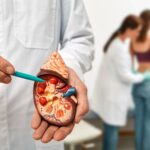dantechviews.com – The main characteristic of jaundice is the color change in a number of body parts to yellow. This jaundice can attack anyone, but has the potential to have a higher risk if experienced by patients who have a history of certain diseases, ranging from obesity, drug users, and so on.
To overcome this condition, jaundice can be treated by providing additional nutrition, phototherapy, immunoglobulin injections, and exchange transfusions. Want to know more about the characteristics of jaundice? Check out the information in the article below.
Characteristics of Jaundice
Adapting the National Health Service page, jaundice is the appearance of a yellow color on the sclera of the eyes, mucosa and skin due to increased levels of bilirubin in the blood. For information, bilirubin is a substance that is formed normally from the process of breaking down red blood cells in the body.
Under normal circumstances, the bilirubin level in the blood does not exceed 1 mg/dL (17 µmol/L) and if the bilirubin level in the blood exceeds 1.8 mg/dL (30 µmol/L) it will cause jaundice or jaundice.
If the blood bilirubin level exceeds 2 mg%, jaundice or a yellow substance will appear. Jaundice occurs due to increased levels of indirect (unconjugated) bilirubin and/or direct (conjugated) bilirubin levels.
According to the Cleveland Clinic website, the increase in bilirubin production is caused by a decrease in the lifespan of red blood cells and an increase in early bilirubin. In addition, bilirubin levels can also be caused by increased recirculation through the enterohepatic shunt and increased βglucuronidase activity.
This condition can be found in babies less than 7 days old. Because the baby’s liver cannot work optimally. However, there is no need to worry about this situation because jaundice in babies will disappear along with breast milk intake.
So what are the characteristics of jaundice that you need to know? Adapting the Mayo Clinic page, here is the information.
1. Urine that changes color to yellow
The most important symptom is the change in urine to yellow. In general, urine color that changes to dark yellow indicates dehydration. However, urine that is too yellow and does not go away after consuming lots of water can indicate jaundice.
2. Yellowing of the skin and eyes
Apart from the urine color turning yellow, the skin and eyes also turn yellow. Unfortunately, this symptom is difficult to detect in people with dark skin.
However, keep in mind that if the skin is yellow and the eyes are not yellow, it is likely that the condition is not jaundice.
3. Itching
Another characteristic of jaundice is itching or pruritus. This itching occurs in obstructive type jaundice.
This type of obstructive jaundice is caused by blockage of the bile ducts. If the bile duct is blocked, administration of bile for bilirubin metabolism fails.
Is Jaundice Dangerous?
According to the Medical News Today page, jaundice can be indicated as a serious problem for the function of white blood cells and several organs, namely the liver, pancreas and gallbladder.
In urban areas of Africa and South America, the vector is Aedes aegypti. This disease is a dangerous infectious disease. The death rate for this disease ranges from 20-50%, but in severe cases it can exceed 50%. Until now, no specific treatment has been found for this disease.
If not treated properly, jaundice in babies can put them at risk of brain damage, hearing loss, or cerebral palsy. Meanwhile, adults who suffer from jaundice can cause complications such as anemia, bleeding, infection, organ failure, and even cancer.
Can jaundice cure itself?
Some jaundice can be cured, but there is also a small chance of cure, especially in advanced stages. This disease is difficult to cure on its own.
However, there is no need to worry, because there are several treatments that can be done. Adapting the Mayo Clinic page, here are several treatments for jaundice that can be done.
1. Pre-hepatic
Treatment of pre-hepatic jaundice aims to prevent red blood cells from being destroyed too quickly or too much. For this treatment, the doctor can prescribe antimalarial drugs, such as doxycycline or chloroquine.
2. Intrahepatic
Treatment of intrahepatic jaundice aims to prevent the spread of damage to the liver and repair the damage. If liver damage is caused by the habit of consuming alcoholic drinks, doctors recommend stopping this habit.
However, if jaundice is caused by infection, the doctor will recommend taking antiviral drugs. If the condition gets worse, the doctor will recommend a liver transplant.
3. Post-hepatic
Treatment of post-hepatic jaundice aims to remove blockages in the bile and pancreatic ducts. In post-hepatic jaundice which occurs due to bile duct stones, the doctor will remove the stones through surgery.
Baca Juga :




Leave a Reply